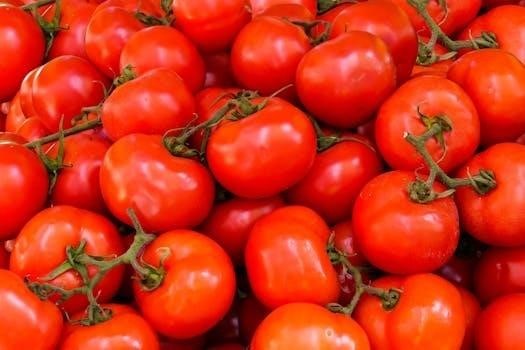Plant Paradox Meal Plan PDF⁚ An Overview
This guide offers various meal plans, from 3-day cleanses to 52-week options, all in downloadable PDFs. These PDFs include recipes, shopping lists, and budget-friendly, lectin-free meal ideas, along with sample menus.
The Plant Paradox Diet, developed by Dr. Steven Gundry, centers on balancing the gut microbiome through a carefully selected, lectin-free food approach. This diet is based on the premise that lectins, proteins found in many plants, can negatively impact digestive health. The Plant Paradox diet is more than just a low lectin diet; it also incorporates many other factors regarding digestive health. It’s broken into three phases, each having its own list of allowed and not allowed foods, gradually expanding as you progress through the diet. The core idea is to remove “Trojan horse” foods that disrupt the body and replace them with neutral alternatives. The diet also emphasizes organic and non-GMO produce when possible.
Understanding Lectins and Their Impact
Lectins, according to the Plant Paradox theory, are proteins found in many plants that can cause inflammation and other health issues. These compounds are viewed as a plant’s natural defense mechanism, and the diet emphasizes their potential negative impact on the human gut. By consuming foods high in lectins, it is believed that the gut microbiome can be disrupted, which may lead to various health problems. The Plant Paradox Diet aims to minimize lectin intake by excluding certain food groups, such as grains, beans, legumes, and specific vegetables. Understanding lectins’ role is crucial to adopting the diet, allowing for targeted removal and replacement with alternatives that support gut health.

Key Components of a Plant Paradox Meal Plan
The Plant Paradox meal plan is structured around Dr. Gundry’s food pyramid, categorizing foods by lectin content. It also includes phased dietary approaches for optimal health results.
Dr. Gundry’s Food Pyramid and Categorization
Dr. Gundry’s food pyramid is a crucial element of the Plant Paradox diet, organizing foods based on their lectin content. This categorization helps individuals identify which foods to prioritize and which to avoid. The pyramid typically places low-lectin foods at the base, such as leafy green vegetables, and foods higher in lectins towards the top, like grains and nightshades. This visual representation provides a clear guide for meal planning and grocery shopping, simplifying the process of following the diet. Understanding this hierarchy is essential for effectively reducing lectin intake and promoting gut health, which is the core principle of the Plant Paradox diet. It is a unique approach compared to other dietary guidelines.
Plant Paradox Diet Phases⁚ A Detailed Look
The Plant Paradox diet is structured into three distinct phases, each with its specific dietary guidelines. Phase 1 focuses on eliminating lectin-rich foods and other potential disruptors to gut health, emphasizing leafy greens and specific proteins. Phase 2 expands the food choices, introducing some lectin-containing foods strategically while continuing to prioritize gut health. Phase 3 is a maintenance phase, designed to allow for a more flexible approach to food, while still following the foundational principles of lectin avoidance. This phased approach allows for a gradual adaptation to the diet and helps individuals understand how different foods affect their bodies. The goal is a long-term sustainable eating pattern.

Practical Resources for Meal Planning
Numerous downloadable PDF resources exist, including 3-day, 30-day, and 52-week meal plans. These resources also include lectin-free shopping lists to simplify the diet’s implementation.
Downloadable PDF Meal Plans⁚ 3-Day, 30-Day, and 52-Week Options
The Plant Paradox diet offers structured meal plans accessible through downloadable PDFs, catering to various commitment levels. These include a 3-day cleanse for a quick reset, a 30-day plan for a more substantial dietary shift, and a comprehensive 52-week option for long-term adherence. These PDF resources typically contain detailed daily meal suggestions, encompassing breakfast, lunch, dinner, and snacks, all adhering to the principles of lectin avoidance. Each plan is crafted to guide users through the diet’s phases, providing a clear path for individuals to achieve their health goals. The PDFs often incorporate shopping lists and recipe links, making meal preparation convenient and straightforward, thus supporting adherence to the Plant Paradox lifestyle.
Lectin-Free Shopping Lists and Food Lists
Navigating the Plant Paradox diet requires a clear understanding of lectin-containing foods and their alternatives. To aid in this, readily available lectin-free shopping lists and food lists are essential tools. These lists categorize foods based on their lectin content, typically dividing them into “yes” and “no” categories, aligning with Dr. Gundry’s food pyramid. The lists often include a breakdown of food groups, such as fruits, vegetables, proteins, and grains, clearly indicating which items are compliant with the diet. Moreover, some lists are organized by levels, reflecting the different phases of the Plant Paradox program, allowing for phased integration of foods. These resources are designed to streamline grocery shopping, simplifying the process of adopting a lectin-free lifestyle.

Meal Prep and Recipe Ideas
This section provides sample weekly menus and adaptable meal plans, along with lectin-free recipes for various meals. These resources will aid in efficient and enjoyable meal preparation.
Sample Weekly Menus and Adaptations
This part of the guide offers sample weekly menus to provide a practical starting point for following the Plant Paradox diet. These menus are designed to be flexible, allowing for adaptations based on individual preferences and dietary needs. For instance, a sample breakfast might include coconut yogurt with blueberries, while lunch could be a hearty salad with approved vegetables and proteins. Dinner options could range from roasted cauliflower with herbs to chicken breast with a side of arugula salad. The provided menus act as a template, showcasing how to incorporate lectin-free foods into your daily meals. These samples are not fixed; they can be adjusted to include your favorite approved ingredients and recipes. They are a tool to help you get comfortable with lectin-free cooking and meal planning. Furthermore, these menus are designed to support both phase 1 and phase 2 of the diet. Remember to always check the approved food list for any substitutions.
Lectin-Free Recipes for Various Meals
This section provides a collection of lectin-free recipes, encompassing breakfast, lunch, dinner, and snacks. These recipes are designed to be both delicious and compliant with the Plant Paradox diet. For example, breakfast might feature green smoothies, while lunch could include creative salads and hearty soups. Dinner options could range from simple roasted meats with vegetables to more elaborate dishes, ensuring variety and satisfaction. Snack recipes focus on quick, easy-to-prepare options, using approved ingredients like nuts, seeds, and certain fruits. Each recipe includes clear instructions and ingredient lists, making it easy for anyone to follow, whether they are experienced cooks or just beginning their journey into lectin-free eating. The goal of these recipes is to show that eating within the Plant Paradox guidelines does not mean sacrificing flavor or enjoyment of food. Furthermore, the recipes aim to support both phase 1 and phase 2 of the diet.

Additional Resources and Support
Explore the Plant Paradox Cookbook for more recipes. Find community and online support for the diet. These resources offer extra help and guidance.
The Plant Paradox Cookbook and Other Publications
The Plant Paradox Cookbook, by Dr. Steven Gundry, offers 100 delicious recipes to support weight loss, gut health, and a lectin-free lifestyle. It serves as a practical companion to the original book, providing a wealth of meal ideas. Additionally, “The Plant Paradox Quick and Easy” simplifies the diet further, offering a 30-day challenge with meal plans, shopping lists, and time-saving cooking strategies. These publications, along with others by Dr. Gundry, provide comprehensive resources for those looking to adopt and maintain a lectin-free eating approach. They are great references for understanding the principles behind the diet and finding inspiration for delicious, compliant meals.
Community and Online Support for the Diet
Navigating the Plant Paradox diet can be easier with community support. Online forums and groups provide spaces for individuals to share experiences, recipes, and tips; These communities offer encouragement and help troubleshoot challenges. Many resources also provide weekly updates, helping you stay informed and motivated. Furthermore, numerous websites and blogs feature lectin-free recipes, shopping guides, and meal plans. These resources, combined with the support of others on the same journey, can make the transition to a Plant Paradox lifestyle smoother and more enjoyable. You can find valuable advice and inspiration, and connect with others who understand the unique dietary needs of the plan.
